
Digital Transformation
Strategies to Thrive
in Post Pandemic World
White Paper
Executive Summary
Economic slowdown caused by COVID 19 is the worst since the great depression. The level of business disruption is unprecedented, and the necessity of digital transformation was never more acute, as it is today. The circumstance decrees even remotely analog incumbents to restructure their business with a digital mindset.
Experts foresee a further rise in already prodigiously growing investments in digital technologies. Though it does not imply that success rates would be higher; contrary could be true.
There is one silver lining in this chaos and it is the higher acceptance to experimentation, risk and change. History has rewarded bold moves and now they may find further support both within the organization as well as with customers.
Digital strategy would play a sterling role now, as a large number of companies would undergo the digital ablution. Timid moves, tolerance for legacy systems, ignorance of change management and talent planning would substantially undermine the odds of success. On the other hand, a customer centric outside-in approach that strives to harness data in furthering customer experience and decision making would bolster the chances of success.
In this paper we have garnered learning from leading research and have interviewed industry leaders to unravel the core issues of digital transformation and to formulate the strategy suitable for contemporary crisis.

Digital Transformation & the New Paradigm
Recessions come and go, fortunes wax and wane, but each crisis leaves a distinct imprint on human lives. Companies today are facing a once-in-a-generation shift and experts believe that this would be the watershed moment for Digital Transformation (DX); from being the prerogative of a few to an existential necessity of the majority.
The global spending on technologies and services that facilitate digital transformation is expected to grow at an impressive CAGR of 17.1% to reach USD 2.3 trillion by 2023, according to the International Data Corporation (IDC), and the US would be the lead investor.
Aproaching a Milestone: By 2023, over 50% of tech investments would be on digital transformation.
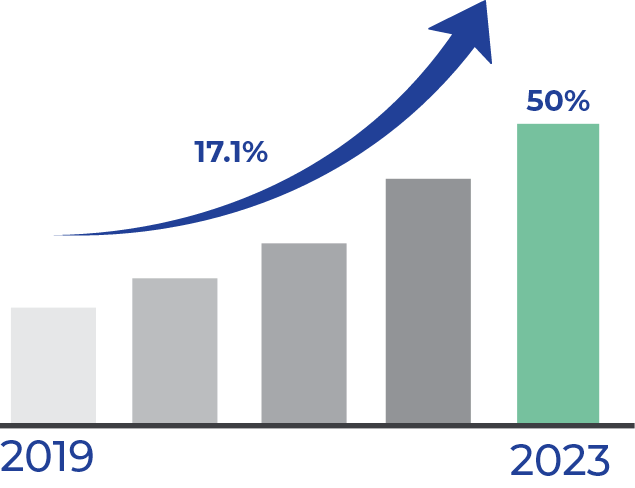
What is more remarkable is that estimates predict that over 50% of total worldwide technology investment would be on digital transformation by 2023. But it is a pre-COVID-19 era estimate; today, many experts opine that the spending would further ramp up.
Pandemic is expected to accelerate investments in digital transformation technologies

Looking into the world with the prism of circumstance, the time frame of digital transformation has suddenly accelerated. 2020 may ring parting knell for organizations that are slow to change and could bring hardships to those who have admired themselves with a digital lipstick.
For companies with a digital vision and an agile mindset, the crisis would unlock more growth opportunities and a chance to capture greater market share. In a post-crisis world a lot would have changed forever, so playing safe would be the least recommended move.
The Long Odds
In 2018, a mind-boggling $1.3 trillion was spent on digital transformation, of which two-thirds failed to come to fruition. Around $ 900 bn , which is more than the GDP of 172 nations, evaporated in failed digital transformation efforts. An inquiry into the fundamental cause of failure, in the present context, seems paramount.
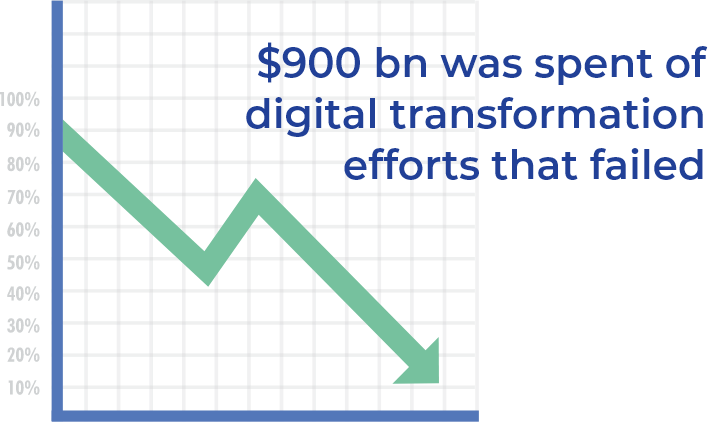
Unveiling the Nucleus of Digital Transformation
In a brief interview with Techment Technology, Behnam Tabrizi, world’s leading organizational transformation expert, best-selling author, and Stanford professor shared the most profound irony on why digital transformation efforts fail; “Digital transformation is not just about technology, it is about people, process and change management. Transformation of sub-optimal processes would only magnify the inefficiencies rather than addressing them."
A digital reimagination of business, supported by a clear digital strategy is at the core of a DX. Every firm is at a different stage of digital maturity, which has an impact on their approach towards digital changes. Research2 by premier institutes brings out interesting facts that have been put to use by us in decoding central issues faced by organizations at different stages of digital maturity.
Most companies fail because they think digital transformation journey begins with technology, ironically it ends with it.
| Early | Developing | |
|---|---|---|
| Barrier | Lack of Strategy | Managing Distractions- Too many competing priorities |
| Culture | Siloed | Integrating |
| Talent Development | Low Interest | Partially invested in the acquisition of digital skills |
Lack of strategy afflicts the early and developing alike; organizations must walk the extra miles to overcome strategy myopia and further their learning curve. To varying degrees, silos negatively impact DX success; a siloless culture focused on creating an integrated company boosts agility and innovative capabilities. Talent is another domain that firms must acknowledge to move up the DX ladder.
Timid response to change has also been recognized as an important contributor to DX failures. Research by McKinsey3 reveals that the probability of success and output improvement increases about two folds if the firm's approach is bold.
Only one in six companies create a bold strategy at scale, rest have timid attempts at digitization.
The list of reasons that contribute to failures can be long, but fundamentally it boils down to the understanding of the nature of DX, and the strategy to it. There is no quick fix; no glorious edifice could be built overnight without cohesive efforts, a digital strategy. Go back to the drawing board.
In light of the fact that organizations around the world would embark on DX in urgency, we have endeavored to bring to the fore a few of its counterintuitive elements.
Only one in six companies, create a bold strategy at scale
Decoding the 4 Fatal Cognitive Fallacies
Research through the rubble and smoke of failed DXs illuminates main cognitive fallacies to be avoided at all costs. Though it is the technology that consummates the transformation, it is not entirely about technology, else DXs would have a much higher success rate than what it is today.

1. Right Technology Gives Desired Outcomes
Nicholas G. Carr, in a provocative HBR article “IT doesn't Matter”4, 2003, spoke of a paradigm-changing perspective that technology cannot by itself create a competitive advantage as it is available to all. The argument holds more ground today as technology is much more accessible than it was in 2003. Thus, its strategic incorporation takes cardinal importance. Deciding the right technology, its quantum and budget, are all important issues, but they are the easiest ones. Without a meticulous makeover of business strategy, technology may have a retrogressive impact in the long run instead of promoting efficiency and growth.
2. “Automation” the Safest Bet to Efficiency
Inherently inefficient processes won't bring about the change expected out of automation. Marginal gains in efficiency, decision making, consumer experience, etc. do not justify automation efforts and the illusion of being digital may lead to detrimental complacency. Process optimization must precede
automation as the most significant leap forward.
3. Consultants are Best Change Leaders
Digital transformation partners are an indispensable part of the journey and are the most effective when they work with the people of the organization who run the show. It is easy to let them in and lead the change but research reveals that digital transformation is more successful when employees lead the transition.
4. Inside-out Approach is Fast & Effective
The exhaustive research on companies, by Harvard professor Ranjay Gulati5, reveals results perfectly relevant to present turbulent times. His findings reveal that companies who follow an outside-in approach are rare; they deliver exceptional shareholder returns and are far more resilient when times are uncertain. Outside-in approach executed by conducting focused group discussions, listening to social media, and many similar exercises give the necessary stronghold for DX to succeed upon.
Automation applied to an inefficient operation will magnify the inefficiency
-Bill Gates

In an accelerated scenario avoiding these misconceptions would certainly increase the probability of success and sustainability.
The Strategy to Fastrack Digital Transformation in 2020 and Beyond
Speaking with Techment Technology, Rakesh Bhatia, the founder of TheCapitalNet, expressed changes he foresees, “The investments in digital transformation technologies are going to rise. The need was always there across industries, now there is realization and acceptance as well. Today, I see there is an opportunity of an integrated approach to collaboration clubbed with specific business use cases. The incorporation of mere collaboration tools will not lead to competitive advantages.”
Since these are unprecedented times, the strategy to digital transformation must be improvised and emboldened to match the call of the hour. Beyond the obvious, here are the elements of the strategy that have been accentuated by the dictates of time.
"The need was always there across industries, now there is realization and acceptance as well."
Top 8 Strategy to Fastrack Digital Transformation in 2020
The change that the global crisis has ushered in, sets in motion the tectonics for years to come.

Change Management:
There is no well-defined way to manage a change of such volume and diversity. The application of outdated models and change techniques could prove jeopardous for being misaligned with the contemporary business environment. The change must flow top-down, the culture must be polarized towards pro-change, and due care must be tended to ensure that it is not just the technology that transforms, but the culture, behavior, and attitudes too. People must champion the change.
Be Bold, No Lipstick on the Legacy Systems:
Firms must reassess their situation if they have had digitized their processes. Poor access to an organization's data, operations, and just marginal improvement in efficiency and decision making would signify a well masked failure. The digital lipstick on the legacy systems would severely impair a company’s ability to respond to change.
Expand Horizons:
When disruption strikes, there is no benefit of being protective of existing customer verticals. Studies show that digital transformation supported expansion proves better because of lower costs, higher efficiencies and more agile organization is better poised to cater to diverse customers.
Sever Legacy Systems and Models:
It is natural to hold on to old systems and processes, but DX can come to fruition only when a change in one place is supported by the change in the other. Experimentation with new business models, value chains, processes, and strategies are the moves espoused by research.
Demolish Internal Silos:
One vital objective of DX is consumer experience and the presence of silos would create cracks in it as departmental disconnect would not permit the creation of a true picture of customer expectation.
Alignment6 of resources and execution to business strategy is vital, else it creates silos and they are more damaging at these times than they are otherwise. One of the reasons why Airbnb has been so success- ful is because they were able to break the silos between designers, engineers, and researchers. Seamless collaboration, unobstructed by silos facilitates real-time decision making.
Harness Data:
If used wisely, data is power. Huami, manufacturer of fitness bands, is now analyzing the data of its users in Wuhan and nearby regions to develop an early warning system to preempt another spread. Out of every operation, internal as well as external, the data must be harnessed to power analytics and decision making, no transformation is complete without it.
Frequent Data Reviews:
During times of change low frequency of data reviews would impair a company's ability to spot a trend, and miss the opportunity to create a competitive advantage.
Personalize:
Companies must advance digital capabilities to better understand its customers and offer high degrees of personalization. Amazon is the ideal example as it leverages data and analytics to deliver a tailored customer experience.

“If I would have asked people what they wanted, they would have said - faster horses"
- Henry Ford
Don’t go Alone; Engage Collaborative Learning
Technology is the rainmaker for modern businesses. A successful digital transformation can not happen without a long-term commitment to investment in the right technology and in the right technology partner that helps in creating the strategy necessary to operate in a disruptive environment.
Research3 postulates that like network effect, the learning curve is steeper when many entities collaborate and organizations must leverage the advantage that inherently comes with collaborations. Investing in a technology partner who has a varied experience helps in four ways:
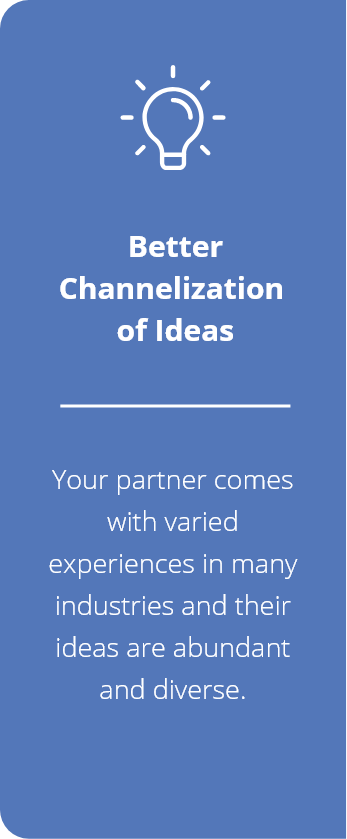
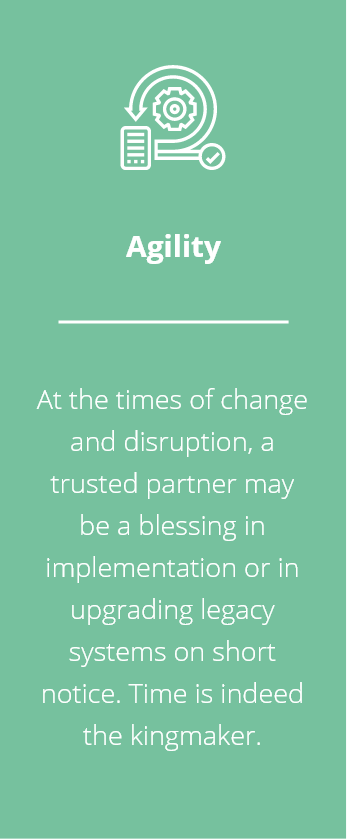
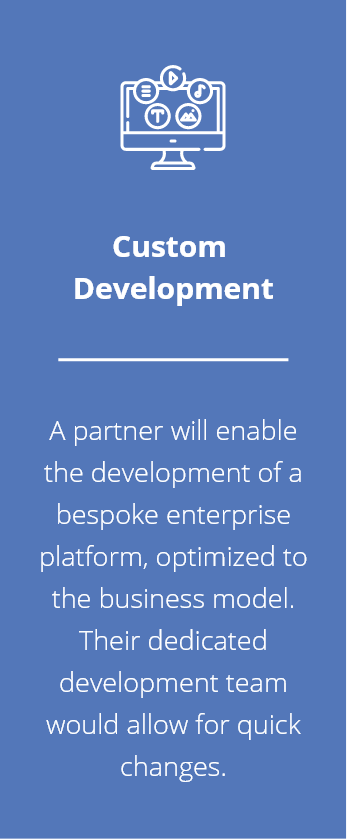

Invest Prudently:
While deciding for a technology partner, identify those with slim tolerance to legacy systems. Your technology partner must be as invested in the project as you are, and must drive the change; choose wisely.
Learning From a Real-Life Success Story
In this section, we are covering an intriguing case study. We studied AVO’s vanguard effort to undergo a digital transformation which proved to be spectacularly successful.
AVO, Pioneering the Digital Transformation in Workers’ Compensation Space
AVO is an American Transportation and Language organization in the worker's compensation industry. It is an inherently complex sector because of the diversity in-laws and regulations. The industry is yet to fully leverage technology and depends on manual operations.
AVO, a managed care provider, faced significant challenges on account of manual processes and all-pervasive lack of automation. Its older platform harbored a labyrinth of inefficient processes, thus the seemingly simple task proved exceedingly tedious.
In an interview with Techment Technology, Gary Nelson, CEO, AVO spoke about the various facets of AVO’s transformation. “We were motivated by the desire to create an agile enterprise, which has an intrinsic capability to scale, and could provide the best and diverse services to an increasing number of injured workers, in a cost-efficient manner,” he said.
Mr. Gary explained that the idea of transforming AVO was the brainchild of AVO’s president Frederick Schafer. The entire leadership team was intimately involved in this makeover. Gary was excited to share that AVO’s team was the one actually leading the transformation; they were the real champions of change. They came up with ideas, tested the new platforms, and mastered the change without the need for special training.
On the question of tangible outcomes, Mr. Gary revealed, “The new system allows us to realize over 100% efficiency gains in both order processing and human capital. We have digitized and automated a significant portion of our operations which enables us to capture data, allowing greater insight into our operations and procedures. Also, real-time data facilitates decision making enabled by insights into profitability.” Mr. Gary enumerated. AVO is still undergoing further transformation and plans to incorporate AI and other advanced tech in the near future.
AVO’s DX Success Determinants :
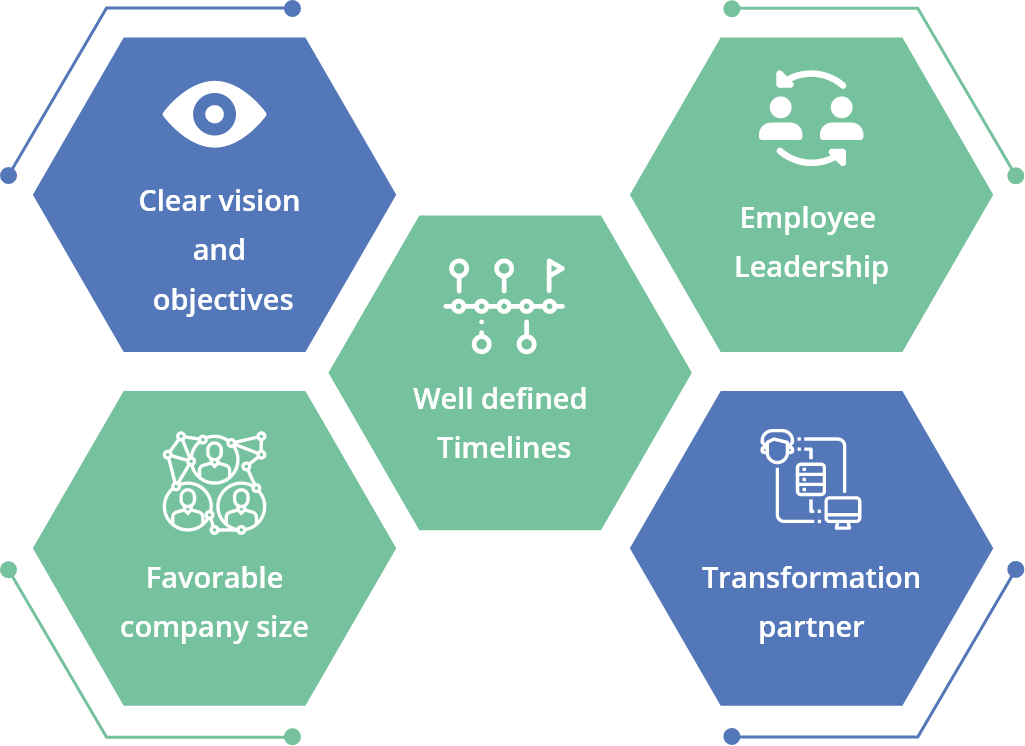
Conclusion
Digital Transformation is Now an Existential Perquisite
As the disruption reaches its crescendo, the rush towards DX would be seen across industries. Strategy, not technology would play a sterling role in DX efforts born amidst the crisis.
The present crisis has created a deep realization and acceptance of transformation. Thus, it comes with a silver lining of increased risk appetite, openness to experimentation, and improvisation in organizations. It seems to be the opportune time for a bold DX effort.
The digital strategy must be wary of the counterintuitive elements of DX. It is not just about technology, but about how it can serve the new business model and optimized processes. Digitization and
automation of suboptimal processes can only bring in lackluster improvements, it is the digital lipstick that puts the company's future in peril.
A strategy of low tolerance to legacy systems, and silos; a strong relationship with equally invested technology partners, focus on harnessing data, and its frequent reviews along with enhancing personalization capabilities would bolster the chances for success.
Companies, to varying degrees, realize the inevitability of digital transformation, and they must make the best out of a once-in-a-generation crisis without dithering, delaying and dawdling.
ACKNOWLEDGMENTS
We thank each of the following individuals, who were interviewed for this paper:
-
Mr. Gary Nelson, CEO, AVO Transportation and Language Services, USA
-
Dr. Behnam Tabrizi, Leading Transformation Expert and Professor Stanford University
-
Mr. Rakesh Bhatia, Digital Transformation Investment Expert and Founder of TheCapitalNet
About Us
Techment Technology is a Digital Catalyst that catalyzes solution development with its high-velocity agile delivery model.
Our team consists of passionate techno-functional experts that bring an outside-in approach and work as an extension of client’s team. We are industry agnostic and work with global organizations of all sizes, including disruptive startups.
Contact Us
REFERENCE
-
Behnam Tabrizi , Ed Lam , Kirk Girard and Vernon Irvin, "Digital Transformation Is Not About Technology", Harvard Business Review, March 2019
-
G. C. Kane, D. Palmer, A. N. Phillips, D. Kiron and N. Buckley, “Strategy, Not Technology, Drives Digital Transformation” MIT Sloan Management Review and Deloitte University Press, July 2015.
-
John Hagel III, John Seely Brown and Lang Davison, “Introducing the Collaboration Curve” Harvard Business Review, April, 2009.
-
Gulati, Ranjay, “Reorganize for Resilience: Putting Customers at the Center of Your Business” Harvard Business Press, 2009
-
Guggal, Jack, “The DNA of Strategy Execution: Next Generation Project Management and PMO” Wiley, 2018
